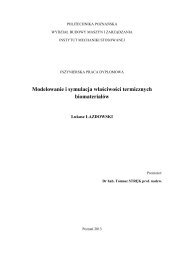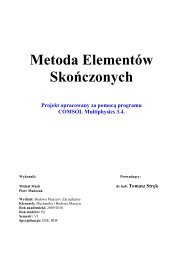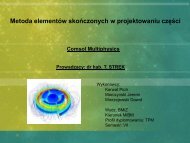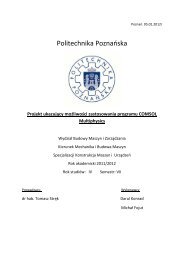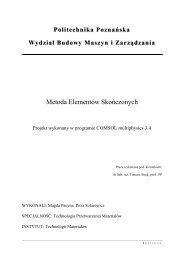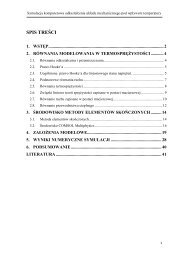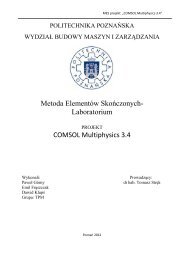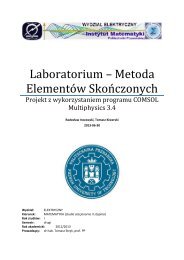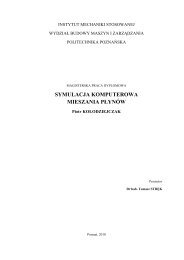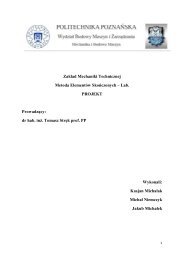Lithium-Ion Battery Simulation for Greener Ford Vehicles
Lithium-Ion Battery Simulation for Greener Ford Vehicles
Lithium-Ion Battery Simulation for Greener Ford Vehicles
You also want an ePaper? Increase the reach of your titles
YUMPU automatically turns print PDFs into web optimized ePapers that Google loves.
ENERGY<br />
MIT, CAMBRIDGE, MA<br />
Modeling Electromagnetic Waves in the Thermonuclear Fusion<br />
Plasmas of the MIT Alcator C-Mod Tokamak<br />
BY O. MENEGHINI, S. SHIRAIWA, M. GARRETT, MASSACHUSETTS INSTITUTE OF TECHNOLOGY, CAMBRIDGE, MASSACHUSETTS<br />
Fusion is a <strong>for</strong>m of nuclear energy heated in the startup phase to its operating<br />
temperature of greater than 10<br />
which has impressive advantages<br />
from the point of view of fuel reserves, keV (over 100 million °C) and additional<br />
environmental impact and safety. If successful,<br />
fusion energy would ensure a tion must be applied.<br />
current beyond that supplied by induc-<br />
safe, resource conserving, environmentally<br />
friendly power supply <strong>for</strong> future ma can be achieved by radio frequency<br />
Heating and current drive in a plas-<br />
generations. To achieve this goal, an<br />
international collaboration, including<br />
Europe, Japan, Russia, USA, China,<br />
South-Korea and India are building the<br />
ITER tokamak which, after 10 years<br />
of construction, will advance fusion researchers'<br />
goal of demonstrating an energy-yielding<br />
plasma on earth. A tokamak<br />
is a device using a magnetic field to<br />
confine a plasma in the shape of a torus.<br />
In an operating tokamak fusion reactor,<br />
part of the energy generated by fusion waves. If electromagnetic waves have<br />
itself will serve to maintain the plasma the correct frequency and polarization,<br />
their energy can be transferred<br />
temperature as fuel is introduced. However,<br />
to achieve the desired levels of fusion<br />
power output the plasma must be In experiments, high power (MW)<br />
to the charged particles in the plasma.<br />
microwaves<br />
are coupled to the plasma<br />
through antennas, which must be designed<br />
to withstand extreme heat loads,<br />
<strong>for</strong>ces and torques. The waves then<br />
propagate from the cool outskirts of the<br />
plasma (100 thousand °C) to the hot<br />
plasma core (10-200 million °C), where<br />
“The FEM approach pushes the boundary of our<br />
simulation capabilities to a new level, where the<br />
modeling possibilities are only limited by<br />
the designers’ imagination.”<br />
they are finally absorbed. Although the<br />
underlying physics of waves in plasmas<br />
is thought to be well understood, modeling<br />
the behavior of the waves in a realistic<br />
environment is still indispensable<br />
to correctly interpret the experimental<br />
results, predict the outcome<br />
of new experiments and<br />
successfully design new antennas.<br />
However, accurately modeling<br />
RF waves in fusion plasmas<br />
is challenging and much<br />
ef<strong>for</strong>t has been spent in this<br />
area of research. The difficulty<br />
comes from the fact that plasma<br />
is a medium which is inhomogeneous,<br />
anisotropic, lossy and<br />
dispersive.<br />
Lower hybrid grill antenna as seen from inside<br />
of the Alcator C-Mod vessel. The arrays of openended<br />
waveguides are phased so to launch the<br />
waves preferentially in one toroidal direction, so<br />
accelerate electrons and ultimately drive current<br />
inside of the plasma.<br />
<strong>Ion</strong> Cyclotron antenna as seen from inside of the<br />
Alcator C-Mod vessel. Four copper straps stand<br />
behind faraday shield rods which have the purpose<br />
of screening the electric field components<br />
which are parallel to the magnetic field lines.<br />
Cold Plasma Modeling<br />
Assuming that the plasma is<br />
cold greatly simplifies the problem<br />
in that the wave dispersion<br />
relation becomes local (i.e. nondispersive)<br />
and perfectly suits<br />
FEM modeling. In particular we<br />
exploited COMSOL Multiphysics<br />
unique capability of allowing the<br />
definition of the full 3D dielectric<br />
tensor of a spatially varying me-<br />
2 4 // C O M S O L N E W S 2 0 1 1<br />
➮<br />
Cov ToC + – A<br />
➭<br />
24-27 CN MIT 2011.indd 24 5/16/11 9:25 AM



